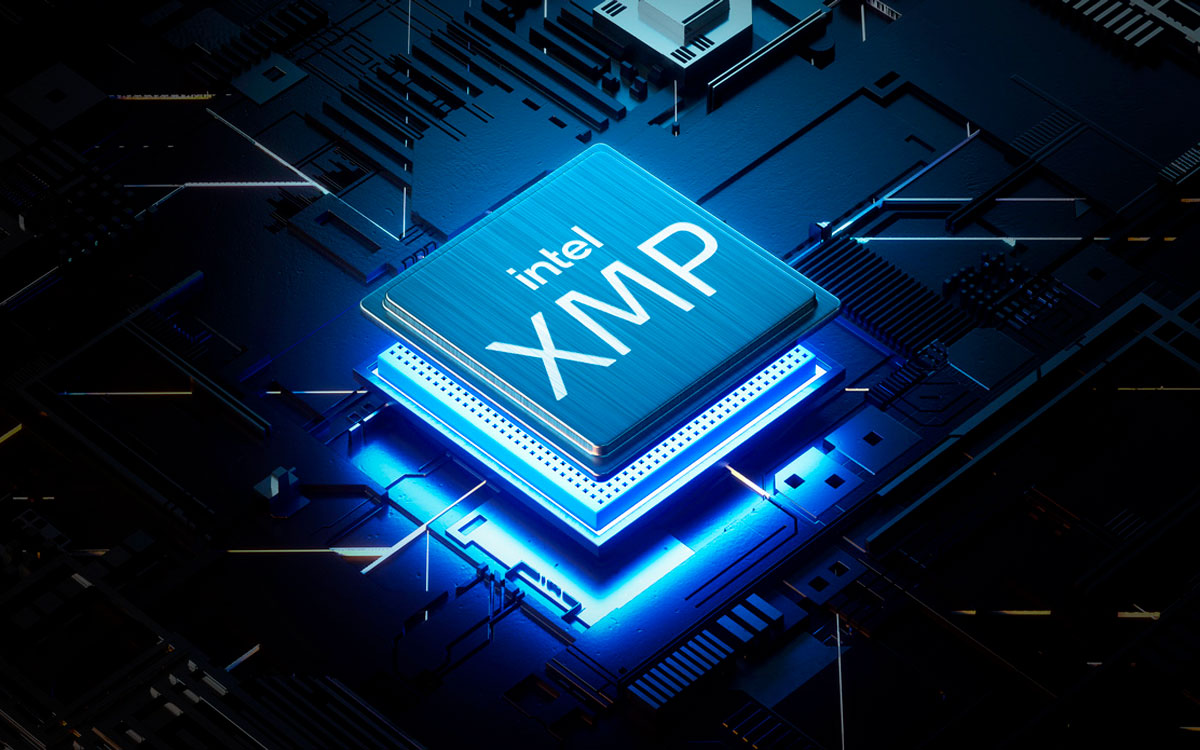
Tired of your memory overclocking (OC) not working or are you unsure about doing one? Intel brings the solution with XMPor Extreme Memory Profilesa technology developed to make it easier for the user to change memory configurations, allowing them to increase their potential to higher capacities or even save on energy consumption.
In this article, understand how it works and how to configure the Intel XMP!
What is XMP and how does it work?
In 2007, Intel launched the Intel XMP 1.1a set of memory configuration profiles embedded in the SPD (Serial Presence Detect) chip of a RAM module, guaranteeing the highest configurations of the time made available by OCZ. Since then, the technology has been present in several brands, having gone through version 2.0 for DDR4 and 3.0 for the current DDR5.
Below we have the main differences between each version of the XMP:
| Version | XMP 1.0 | XMP 2.0 | XMP 3.0 |
| Memory technology | DDR3 | DDR4 | DDR5 |
| Supplier Profiles | 2 | 2 | 3 |
| Rewritable profiles | None | None | 2 |
| Descriptive profiles | No | No | Sim |
| CRC checksum | No | No | Sim |
| Voltage control on the module | No | No | Sim |
| Total bytes allocated to XMP | 78 | 102 | 384 |
O XMP its main function is to be a mold with pre-established memory configurations, ready to operate at clock speeds faster than the frequencies standardized by the JEDEC (organization responsible for the standardization of semiconductor devices). This type of change is especially beneficial for memory-intensive tasks such as video editing, 3D rendering, and gaming.
The main characteristics that are changed by XMP are the timings:
CAS# Latency (tCL): This is the time required for memory to access a specific column of data within a module. It is one of the most important timings and is usually indicated as a number like CL16, CL18, etc.
RAS# to CAS# Delay (tRCD): This timing specifies the time required for memory to access a row of data after having accessed the column (CAS). It is measured in clock cycles.
Row Precharge Time (tRP): Sets the time required to close a row of data before another row can be opened for access.
RAS# Active Time (tRAS): This timing determines how long a data line remains active before being closed (preloaded). It is measured in clock cycles.
Command Rate (CR): Indicates the number of clock cycles needed for the memory to respond to a read or write request. Generally it can be 1T or 2T, where 1T is faster.

For those who are more unfamiliar with the subject, doing an OC is not an easy task and can be done anyway, as we are talking about essential settings for the computer to function. Generally, these changes require a lot of trial and error testing, which avoids the stress of when certain setups work in some programs and actions on the computer but not in others.
O XMP facilitates this entire process by identifying your system’s compatibility and adjusting all settings to the maximum that can be sustained, providing power to the memory, ensuring that it receives the appropriate voltage for optimized performance. This helps achieve stable OC, increasing performance without compromising hardware longevity.
Enabling XMP
Even before activating, it is important to check your motherboard’s compatibility with the memory profile and test system stability before and after enabling the XMP. To activate the XMPyou need to access your computer’s BIOS, where you can find the option to activate the profile XMP of your memory.
The location to change the profile may change depending on the motherboard, but is usually located next to the OC settings. For a detailed change, Check out the video above!
Pros of Intel XMP
- Improved Performance: Enabling XMP can result in a significant increase in system performance, especially in memory-intensive applications.
- Easy to use: With just a few clicks in BIOS, you can improve your memory performance without having to manually adjust settings.
- Stability: XMP profiles are tested and optimized to provide a balance between performance and stability.
Contras do Intel XMP
- Compatibility: Not all motherboards support XMP, and some memory may not function as expected if the XMP profile is not properly supported.
- Guarantee: Using XMP profiles can potentially void the warranty of some components as it is considered a form of OC. So be sure to check the guarantees for the use of your components.
- Initialization: Another complication is that the profile does not initialize with the maximum settings on its own, which can harm those who are more inattentive and inexperienced in carrying out this activation.
Conclusion
O Intel XMP is a powerful tool for those looking to extract maximum performance from RAM memory. With the ease of activation and the promise of a faster system, it’s an attractive option for enthusiasts and professionals alike.
However, it is essential to proceed with caution, ensuring system compatibility and stability to avoid problems. With adequate knowledge and a careful approach, the XMP It can be a great ally in optimizing your PC’s performance.
Credits: What Is XMP, and Why Does It Matter for RAM? – O que são perfis XMP e EXPO e como posso usá-los? – How to Enable Intel XMP to Make Your RAM Run at Its Advertised Speeds.

Join the Adrenaline offer group
Check out the main offers on hardware, components and other electronics that we found online. Video card, motherboard, RAM memory and everything you need to build your PC. By joining our group, you receive daily promotions and have early access to discount coupons.
Join the group and take advantage of promotions
Source: https://www.adrenaline.com.br/artigos/intel-xmp-o-que-e-como-configurar/


